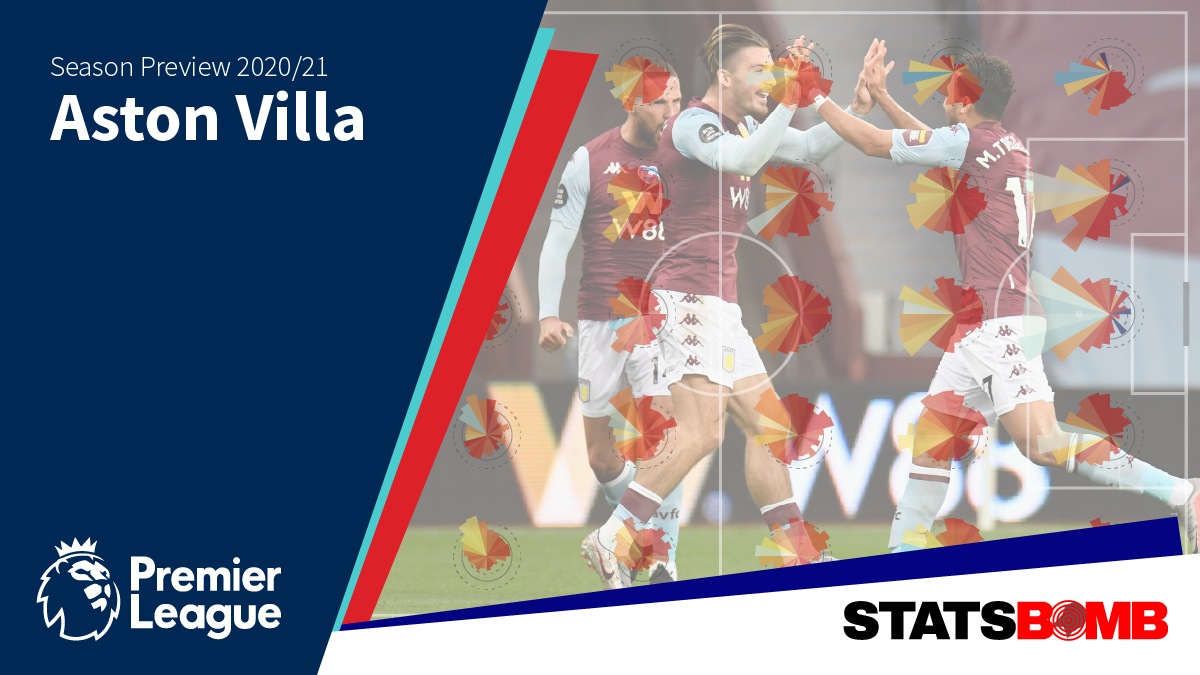The last game of the season, West Ham versus Aston Villa. Six minutes from time, Jack Grealish scored to make it 1-0. The talisman of Villa’s season, the homegrown boy-come-good, had done it again. Villa were safe from relegation.
Within 90 seconds, Andriy Yarmolenko had contrived to equalise. A freak deflection caused the ball to loop over Pepe Reina and make it 1-1. Immediately, Villa’s entire season was back balancing precariously on a knife edge. Fortunately, little of note filled those remaining few, long minutes and Villa’s tenure in the Premier League was extended for another season. They hadn’t done it the easy way--eight points from their last four games were required--but they had done enough, just. For Bournemouth and Watford, this meant disaster, relegation and the acceptance that close only counts in horseshoes and hand grenades.
The transition back to the Premier League was at no point smooth for Villa. The squad arrived at the gates of the big house short-handed and significant investment was required to compete. Last summer, fees of around £130m were agreed to bring in twelve new players and a risky overhaul took place. Was 17th place a good enough return for that investment? Apparently not as large scale changes have now been made to the team involved in that spree. Johan Lange replaced Jesus Garcia Pitarch as Sporting Director and Rob Mackenzie has now arrived as Head of Recruitment. Each has some heritage in using data, with Lange telling Sky Sports in February that while at Copenhagen:
“At the identification phase, our process is very data-driven. We are trying to find players earlier in their career. That is difficult to predict but it is important to try. The partnership between myself, the manager and the scouts is crucial. We take time at the start of the process to establish exactly what we are looking for. Then we can set the parameters with the data. It is only after that stage that it becomes about live scouting.”
Mackenzie is well known in terms of data and recruitment having worked at Leicester, Tottenham, Derby and Leuven while also acting as a mentor for candidates in Opta’s Pro Forum. There have also been changes in the backroom staff with the arrival of Craig Shakespeare, fresh from a semi-successful short tenure with Nigel Pearson at Watford.
Villa’s 2019 recruitment appeared somewhat scattergun (with a curious interest in the Belgian league), while the club has tried and abandoned a data-led strategy before, albeit with Tim Sherwood in charge. Can this time be different? It certainly makes sense to add more accountability to the process and with another potential large scale investment ahead of this new season, the new mens’ moxie will be tested quickly. The fundamental contradiction to overcome here is to buy players for now and a more comfortable season in the Premier League while having half a mind on building for the long term future. It is not always straightforward to balance these two aims, but is paramount here.
The metrics were clear enough in 2019-20: Villa ranked 19th for expected goal difference. However, post lockdown, Villa’s defence was excellent with only Leicester and the two Manchester sides allowing a lower xG Against, and shots against dropping from a woeful 18 per game down to just 10.
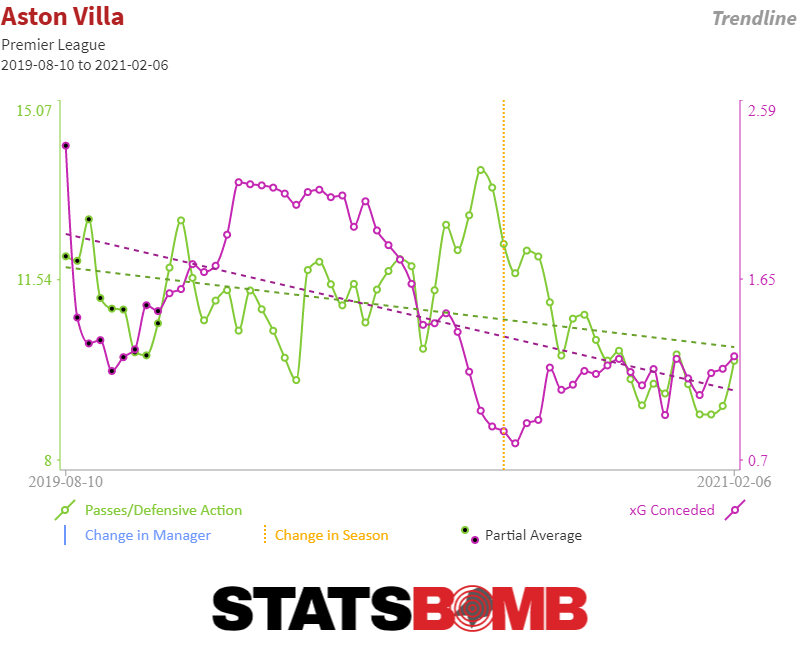
It's unwise to weigh expectation too heavily on the post-break games, but it appears possible to make a case here that Dean Smith and his coaching team were not idle during the enforced break. There is a degree of caution here though again, as typically Smith teams have been somewhat vulnerable to giving up shots, and the whole season line still reads "most shots against" and "most counter attacking shots against".
If the defence is possibly on the right track, the fan view of recruitment comes into play and that is: "we need more attackers". Jack Grealish was the star of Villa’s season, but the advanced left sided position he ended up playing came as much from necessity as suitability. Up front, Wesley was not contributing effectively (5 goals from around 1.6 shots per 90) before a New Year’s Day injury finished his season while his swiftly purchased replacement, Mbwana Samatta fared even worse (one goal from 1.5 shots per 90). Grealish top scored with eight while Trézéguet rescued an otherwise underwhelming season with some key goals down the stretch to get to six. A scorer was lacking and Grealish's strengths alone aren't enough to power an entire attack by himself:
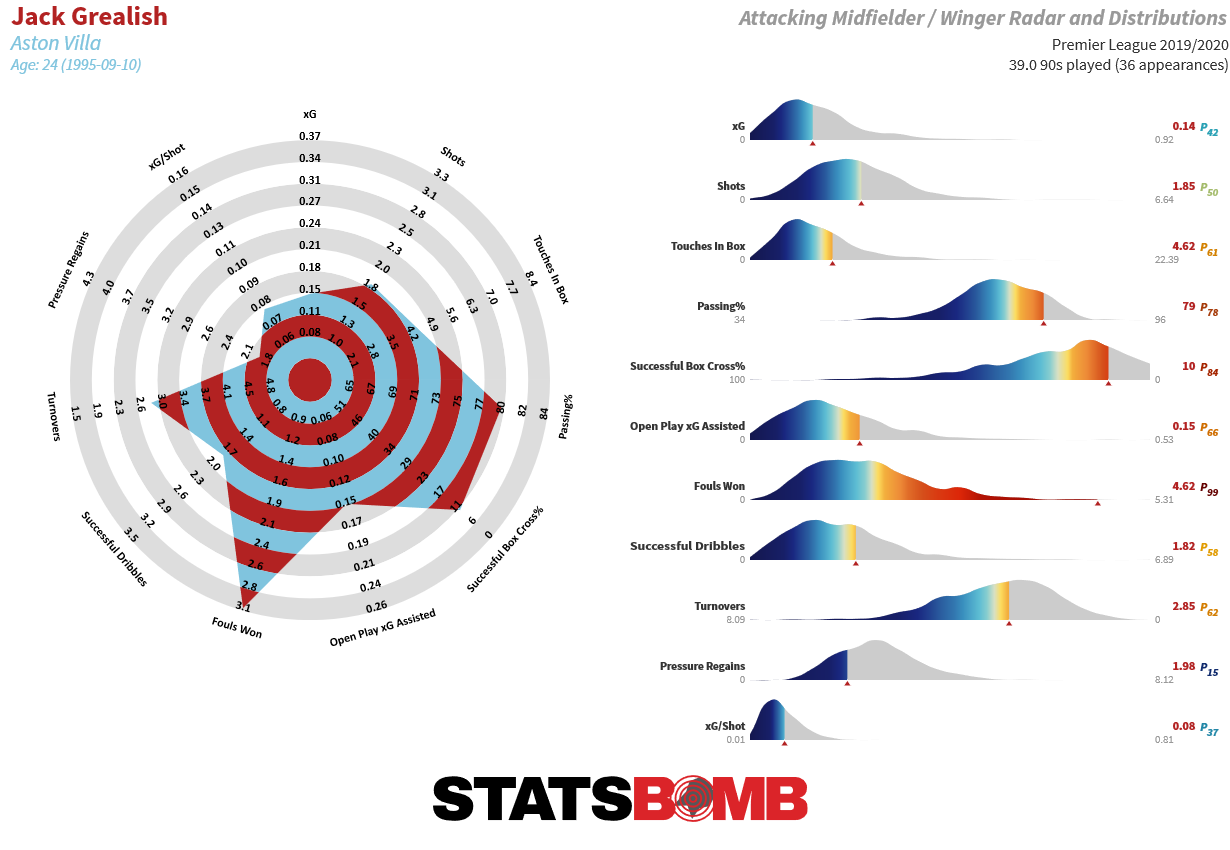
Grealish spent the back half of the season being mercilessly trailed by a sign labelled “Has been fouled more than any other player in the Premier League” that leapt onto TV screens the moment he featured. That trait could be a double edged sword too. Frustratingly Grealish can often kill attacks by holding on too long and drawing the foul, but those fouls can be productive too. Villa’s thirteen goals from set pieces was enough to rank them joint fourth in the division and included five from indirect free kick situations. This was useful as the attack was limp in open play. In ranking in amongst the stragglers both before and after the pandemic break. Villa’s 17th place finish was everything they needed from the season, but from a performance standpoint, it was impossible to upgrade.
The noise on transfers is that some of the Championship's best are being eyed, and the arrival of Matty Cash from Nottingham Forest has finally kicked off the summer's recruitment round. There's a deal of sense behind this move, as Frédéric Guilbert was the starting right back for the whole period in which Villa's defence was awful and played little after the restart while Ahmed El Mohamady is 32 years old and was nominally back-up last season anyway, a role he can continue to play. As a converted wide man, perhaps the attacking instincts of Cash will allow some added contribution down that flank. There is an obvious upgrade with regard to passing, with Cash completing nearly 75% of his passes in or into the final third last season compared to Guilbert down at close to 50%. Cash is more able to carry the ball from deep and when he gets to the final third penetrate the penalty box or get deep, as we can see here:
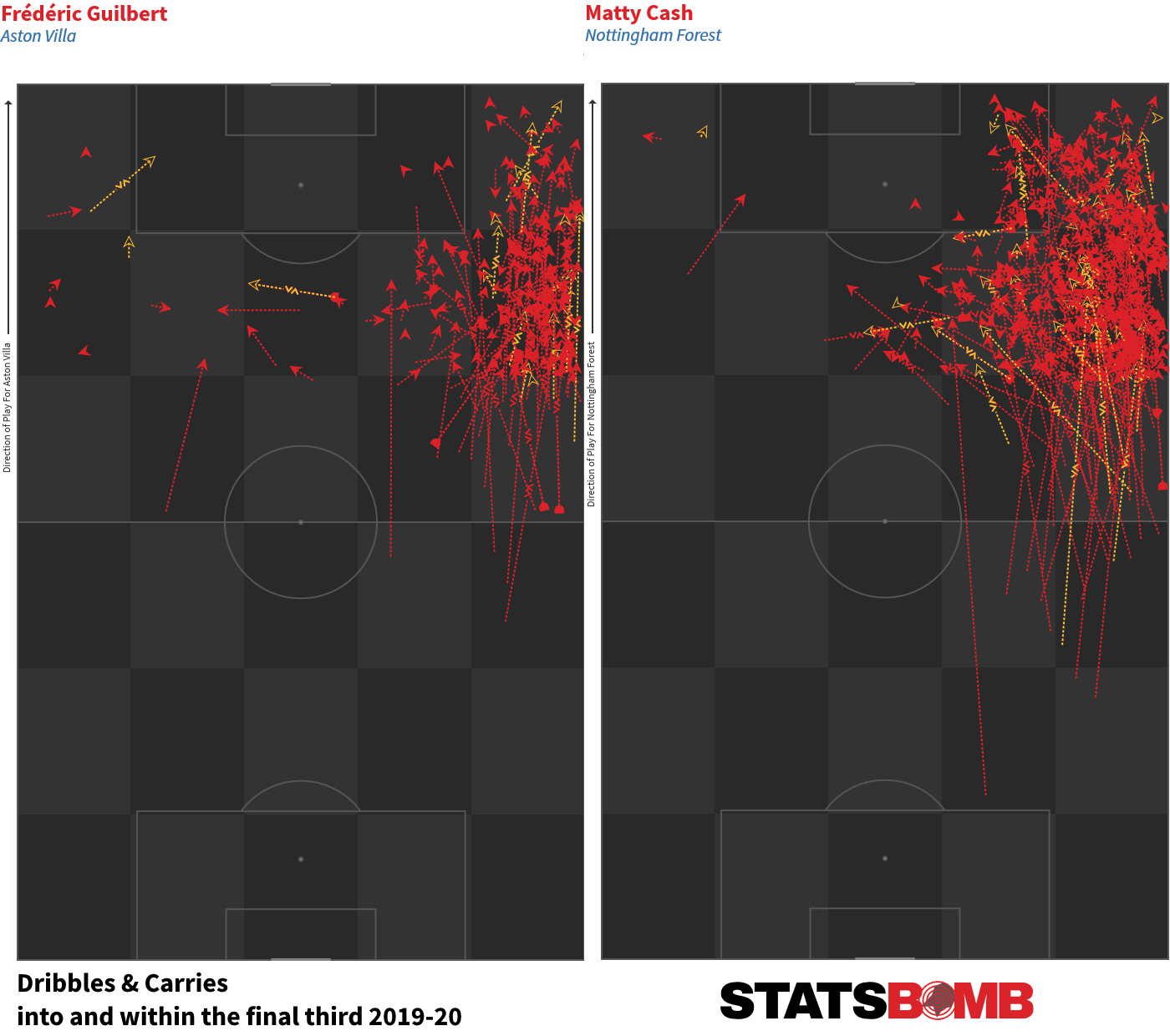
These may sound like small aspects, but it's important that Villa make these incremental improvements in every new player they sign. After Cash, there's still a requirement to beef out goal scoring and goal creation, and it would be no surprise if Villa ended up depositing a large cheque at Brentford for one of their jewels. Ollie Watkins is the obvious play here after his 26 goal 2019-20, but his shot map shows us why alone, he or anyone with a similar shooting profile can't be the last signing:
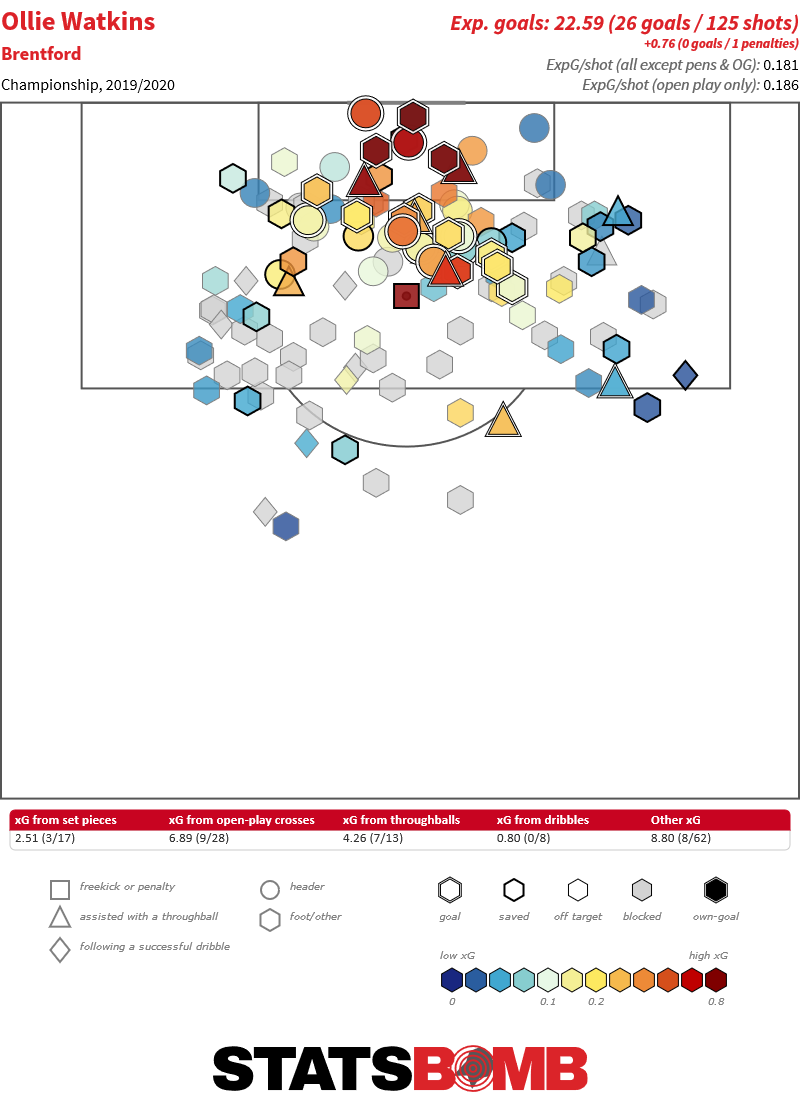
With 24 of 26 goals from within the space between the penalty spot and the goal, he will need providers to give him these chances. Grealish was Villa's only regular starter to average good volume chance creation from open play (close to two per 90, El Mohamady 1.5, then John McGinn at 1.2). He can't do it all.
Projection
So what’s the aim for 2020-21? Firstly it has to be 17th place once more. If Villa can replicate the features of the games they played post-lockdown, they have a great chance of pointing upwards, but we will need to see longer than a ten game stretch to have confidence that this can happen. And if the recruitment side of the organisation is empowered with cold, hard cash, it will be hard to suggest that Villa aren’t doing everything in their power to become a solid Premier league outfit. There also looks to be a good chance that their jewel, Grealish, will be retained. An uncertain Covid-19 world only pushes him deeper into the zone formerly occupied by Wilfried Zaha: too valuable to sell cheaply, too expensive to be a certain purchase for one of the giants.
The Sporting Index opening lines had Villa 18th but very much in the mix with West Brom, Palace, Fulham and Newcastle as the "below 40 points" brigade. It would be trivial of me to suggest all these teams should take a guaranteed 17th place today as I did for Palace, but it remains true enough. Extremely sub-par metrics and close relegation escapes aren't naturally predictive of comfortable mid table finishes. The last few weeks of the transfer window may once more be decisive for Villa. They simply need to get stronger to ensure they can compete better this season and stay clear of trouble.
If you're a club, media or gambling entity and want to know more about what StatsBomb can do for you, please contact us at Sales@StatsBomb.com
We also provide education in this area, so if this taste of football analytics sparked interest, check out our Introduction to Football Analytics course
Follow us on twitter in English and Spanish and also on LinkedIn
